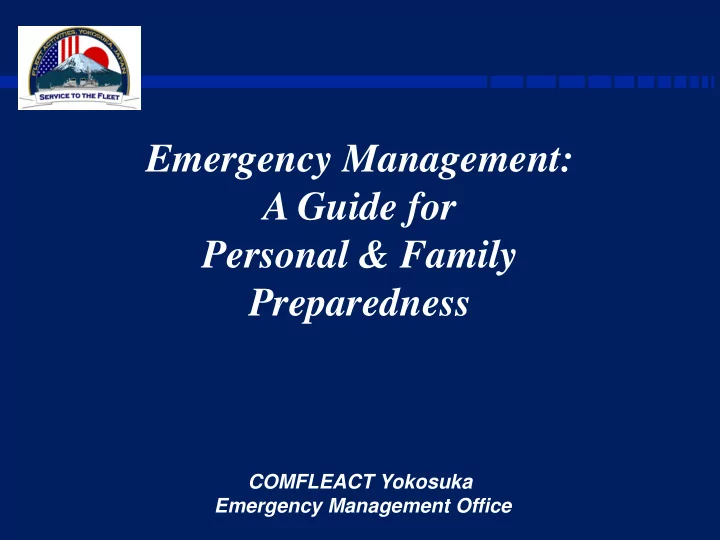

Emergency Management: A Guide for Personal & Family Preparedness COMFLEACT Yokosuka Emergency Management Office
Computer Desktop Notification System (CDNS) GET NOTIFIED!!! • Computer Desktop Notification System (CDNS) provides simultaneous emergency notifications to OneNet computer desktops, as well as home/work emails, and mobile telephones. • These notifications inform community members of emergencies as well as important updates such as Tropical Cyclone Conditions of Readiness (TCCOR) levels, gate closures, facility closures, weather advisories and other information that may impact the community.
CDNS Registration Form CVN76 AUG 2021 Optimus Prime Optimus Prime SELF BLDG 1 APT 1 Optimus.Prime@cvn76.navy.mil Transformers@gmails.com 241-1111 243-2222 080-1234-4567
Natural Hazards in Japan • Earthquakes • Tsunamis • Tropical Cyclones (typhoons)
Earthquakes in Japan The Great Kanto earthquake of 1923 • September 1, 1923, • Richter Scale – 7.9 to 8.3 • Shindo – 7 • Approx 142,800 dead, including around 40,000 missing, presumed dead • Over 2 million displaced • A 10m (33 ft) high tsunami struck Sagami bay and Chiba • 97 km/h (60 mph) winds of a nearby typhoon built up horrifying firestorms • Appx 57 strong aftershocks • Shaking lasted for nearly 4 minutes
Earthquakes in Japan The Great East Japan Earthquake of 2011 • Richter Scale – 9.0 Shaking lasted for nearly 3 • minutes (some reports of up to 6 minutes) • Strong aftershocks (Up to 7.7 same day. 7.1 almost a month later) • 15,894 deaths • 6,152 injured • 2,562 missing • Hundreds of thousands dislocated Damage to nuclear plant • • Over 1 million buildings totally and partially damaged • 4.4 million households without electricity
Outdoor Earthquake Response Stay outside and move away from buildings, powerlines, sinkholes, and gas lines Once in an open area get down low to the ground If in a car, slow down and safely pull over to a clear area, and stay in the car
Indoor Earthquake Response Move away from windows, DROP to the ground, take COVER under a shelter, and HOLD ON! If no shelter is available, get down next to an interior wall DO NOT STAND IN THE DOORWAY!
Tsunamis • Tsunamis are caused by underwater earthquakes • Warnings posted to website & broadcast on local TV • Warning sirens will announce in city areas • Generally, no tsunami threat inside Tokyo Bay • Southern part of Miura and Sagami Bay may be threatened • Obey local warnings • Japan Meteorological Agency • http://www.jma.go.jp/jma/indexe.html
Tsunami Signs The most important information about tsunamis is knowing where the tsunami hazard zones are, where the tsunami evacuation shelters are, and how to get there.
Tropical Cyclone Season • Tropical Cyclone season runs from June to November • About 10 strikes to mainland Japan are possible each typhoon season • TCs can also spawn in South China Sea near Taiwan and move N-NE
Tropical Cyclone Condition of Readiness/TCCOR
Individual and Family Preparedness • Make an individual/family plan • Build and maintain an emergency kit • Be capable of administering basic first aid for yourself and your family • Know where your neighborhood evacuation site is and how to walk there
Emergency Kit Recommended items: • Water, one gallon of water per person per day for at least three days, for drinking and sanitation • Food, at least a three-day supply of non-perishable food • Battery-powered or hand crank radio and a NOAA Weather Radio with tone alert and extra batteries for both • Flashlight and extra batteries • First aid kit • Whistle to signal for help • Dust mask to help filter contaminated air and plastic sheeting and duct tape to shelter-in-place • Moist towelettes, garbage bags and plastic ties for personal sanitation • Wrench or pliers to turn off utilities • Manual can opener for food • Local maps • Cell phone with chargers, inverter or solar charger Source: YOKOSUKA Instruction 3500.1A, NEO Plan
EMERGENCY EVACUATION PROGRAM (EEP) Effective 6 April, 2018, all eligible SOFA personnel assigned to the Japan AOR are required to assemble an evacuation packet utilizing the USFJ Emergency Evacuation Program (EEP) Checklist
EMERGENCY EVACUATION PROGRAM (EEP) • On April 6, 2018 USFJ implemented the USFJ Emergency Evacuation Program (EEP) for all SOFA personnel assigned to the Japan • Sponsors who are eligible evacuees and/or have dependents who are eligible evacuees must prepare an evacuation packet utilizing the USFJ EEP Checklist • Who are eligible evacuees? – Non-mission essential US civilians (appropriated and NAF) and contractors and their dependents – Dependents of military personnel
EMERGENCY EVACUATION PROGRAM (EEP) The USFJ EEP Checklist, fillable PDF forms, and instructions on completing the forms are available on the CFAY Homepage: - Select Emergency Management under the Operations and Management tab. - To download the file, right-click the EEP button and select "Save link as“ from the drop down menu. - Your unit EEP Coordinator or Warden will be your point of contact for EEP preparedness! Newly assigned personnel have 60 days to prepare their USFJ-compliant EEP packet from first day of AOB/ICR! If you have already assembled an older version of an evacuation packet, you must update your packet utilizing the USFJ EEP checklist by July2018.
http://www.ready.gov/considerations/military-family-preparedness Log in to the Navy Family Accountability and Assessment System (NFAAS) Family members will need their sponsor’s date of birth and social security number to log in. If a computer is not accessible, call the Navy Personnel Command Emergency Coordination Center (NPC ECC): 1-877-414-5358 or 1- 866-297-1971 (TDD).
Recommend
More recommend